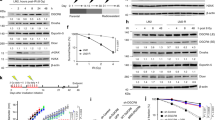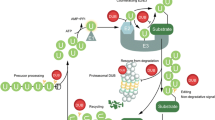Abstract
DNA damage repair is an important cell function for genome integrity and its deregulation can lead to genomic instability and development of malignancies. Sumoylation is an increasingly important ubiquitin-like modification of proteins affecting protein stability, enzymatic activity, nucleocytoplasmic trafficking, and protein-protein interactions. In particular, several important DNA repair enzymes are subject to sumoylation, which appears to play a role in copping with DNA damage insults. Recent reports indicate that Ubc9, the single SUMO E2 enzyme catalyzing the conjugation of SUMO to target proteins, is overexpressed in certain tumors, such as lung adenocarcinoma, ovarian carcinoma and melanoma, suggestive of its clinic significance. This review summarizes the most important DNA damage repair pathways which are potentially affected by Ubc9/SUMO and their role in regulating the function of several proteins involved in the DNA damage repair machinery.
Similar content being viewed by others
References
Aoki K, Ishida R, Kasai M (1997) Isolation and characterization of a cDNA encoding a Translin-like protein, TRAX. FEBS Lett 401:109--12
Azuma Y, Arnaoutov A, Dasso M (2003) SUMO-2/3 regulates topoisomerase II in mitosis. J Cell Biol 163:477--87
Baba D, Maita N, Jee J-G, Uchimura Y, Saitoh H, Sugasawa K, Hanaoka F, Tochio H, Hiroaki H, Shirakawa (2005) Crystal structure of thymidine DNA glycosylase conjugated to SUMO-1. Nature 435:979--82
Bouchard VJ, Rouleau M, Poirier GG (2003) PARP-1, a determinant of cell survival in response to DNA damage. Exp Hematol 31:446--54
Buschmann T, Lerner D, Lee CG, Ronai Z (2001) The Mdm-2 amino terminus is required for Mdm2 binding and SUMO-1 conjugation by the E2 SUMO-1 conjugating enzyme Ubc9. J Biol Chem 276:40389--0395
Chen L, Chen J (2003) MDM2-ARF complex regulates p53 sumoylation. Oncogene 22:5348--357
Chiu H, Ring BC, Sorrentino RP, Kalamarz M, Garza D, Govind S (2005) dUbc9 negatively regulates the Toll-NF-kappaB pathways in larval hematopoiesis and drosomycin activation in Drosophila. Dev Biol 288:60--72
Eladad S, Ye TZ, Hu P, Leversha M, Beresten S, Matunis MJ, Ellis NA (2005) Intra-nuclear trafficking of the BLM helicase to DNA damage-induced foci is regulated by SUMO modification. Hum Mol Genet 14:1351--365
Girdwood D, Bumpass D, Vaughan OA, Thain A, Anderson LA, Snowden AW, Garcia-Wilson E, Perkins ND, Hay RT (2003) P300 transcriptional repression is mediated by SUMO modification. Mol Cell 11:1043--054
Gocke CB, Yu H, Kang J (2005) Systematic identification and analysis of mammalian small ubiquitin-like modifier substrates. J Biol Chem 280:5004--012
Gu S, Du Y, Chen J, Liu Z, Bradbury EM, Hu CA, Chen X (2004) Systematic identification and analysis of mammalian small ubiquitin-like modifier substrates. J Proteome Res 3:1191--00
Hannich JT, Lewis A, Kroetz MB, Li SJ, Heide H, Emili A, Hochstrasser M (2005) Defining the SUMO-modified proteome by multiple approaches in Saccharomyces cerevisiae. J Biol Chem 280:4102--110
Hardeland U, Steinacher R, Jiricny J, Schar P (2002) Modification of the human thymine-DNA glycosylase by ubiquitin-like proteins facilitates enzymatic turnover. EMBO J 21:1456--464
Harris SL, Levine AJ (2005) The p53 pathway: positive and negative feedback loops. Oncogene 24:2899--908
Hay RT (2005) SUMO: a history of modification. Mol Cell 18:1--2
Hayashi T, Seki M, Maeda D, Wang W, Kawabe Y, Seki T, Saitoh H, Fukagawa T, Yagi H, Enomoto T. (2002) Ubc9 is essential for viability of higher eukaryotic cells. Exp Cell Res 280:212--21
Heale JT, Ball AR, Schmiesing JA, Kim J-S, Kong X, Zhou S, Hudson DF, Earnshaw WC, Yokomori K (2006) Condesin I interacts with the PARP-1-XRCC1 Complex and functions in DNA single-strand break repair. Mol Cell 21:837--48
Hoege C, Pfander B, Moldovan GL, Pyrowolakis G, Jentsch S (2002) RAD6-dependent DNA repair is linked to modification of PCNA by ubiquitin and SUMO. Nature 419:135--41
Huang TT, Wuerzberger-Davis SM, Wu ZH, Miyamoto S (2003) Sequential modification of NEMO/IKKgamma by SUMO-1 and ubiquitin mediates NF-kappaB activation by genotoxic stress. Cell 115:565--76
Isik S, Sano K, Tsutsui K, Seki M, Enomoto T, Saitoh H, Tsutsui K (2003) The SUMO pathway is required for selective degradation of DNA topoisomerase IIbeta induced by a catalytic inhibitor ICRF-193(1). FEBS Lett 546:374--78
Jacquiau HR, van Waardenburg RC, Reid RJ, Woo MH, Guo H, Johnson ES, Bjornsti MA (2005) Defects in SUMO (small ubiquitin-related modifier) conjugation and deconjugation alter cell sensitivity to DNA topoisomerase I-induced DNA damage. J Biol Chem 280:23566--3575
Kannouche PL, Wing J, Lehmann AR (2004) Interaction of human DNA polymerase eta with monoubiquitinated PCNA: a possible mechanism for the polymerase switch in response to DNA damage. Mol Cell 14:491--00
Kawabe Y, Seki M, Seki T, Wang W-S, Imamura O, Furuichi Y, Saitoh H, Enomoto T (2000) Covalent modification of the Werner’s syndrome gene product with the ubiquitin-related protein, SUMO-1. J Biol Chem 275:20963--0966
Kovalenko OV, Plug AW, Haaf T, Gonda DK, Ashley T, Ward DC, Radding CM, Golub EI (1996) Mammalian ubiquitin-conjugating enzyme Ubc9 interacts with Rad51 recombination protein and localizes in synaptonemal complexes. Proc Natl Acad Sci USA 93:2958--963
Kurki S, Peltonen K, Latonen L, Kiviharju TM, Ojala PM, Meek D, Laiho M (2004) Nucleolar protein NPM interacts with HDM2 and protects tumor suppressor protein p53 from HDM2-mediated degradation. Cancer Cell 5:465--75
Leach CA, Michael WM (2005) Ubiquitin/SUMO modification of PCNA promotes replication fork progression in Xenopus laevis egg extracts. J Cell Biol 171:947--54
Li W, Hesabi B, Babbo A, Pacione C, Liu J, Chen DJ, Nickoloff JA, Shen Z (2000) Regulation of double-strand break-induced mammalian homologous recombination by UBL1, a RAD51-interacting protein. Nucleic Acids Res 28:1145--153
Lin JY, Ohshima T, Shimotohno K, Schmidt D, Muller S (2004) Association of Ubc9, an E2 ligase for SUMO conjugation, with p53 is regulated by phosphorylation of p53. FEBS Lett 573:15--8
Ling Y, Sankpal UT, Robertson AK, McNally JG, Karpova T, Robertson KD (2004) Modification of de novo DNA methyltransferase 3a (Dnmt3a) by SUMO-1 modulates its interaction with histone deacetylases (HDACs) and its capacity to repress transcription. Nucleic Acids Res 32:598--10
Ljungman M (2000) Dial 9-1-1 for p53: mechanisms of p53 activation by cellular stress. Neoplasia 2:208--25
Manza LL, Codreanu SG, Stamer SL, Smith DL, Wells KS, Roberts RL, Liebler DC (2004) Global shifts in protein sumoylation in response to electrophile and oxidative stress. Chem Res Toxicol 17:1706--715
Mao Y, Sun M, Desai SD, Liu LF (2000) SUMO-1 conjugation to topoisomerase I: a possible repair response to topoisomerase-mediated DNA damage. Proc Natl Acad Sci USA 97:4046--051
Masson M, Menissier-de Murcia J, Mattei MG, de Murcia G, Niedergang CP (1997) Poly(ADP-ribose) polymerase interacts with a novel human ubiquitin conjugating enzyme: hUbc9. Gene 190:287--96
McDoniels-Silvers AL, Nimri CF, Stoner GD, Lubet RA, You M (2002) Differential gene expression in human lung adenocarcinomas and squamous cell carcinomas. Clin Cancer Res 8:1127--138
Melchior F, Hengst L (2002) SUMO-1 and p53. Cell Cycle 1:245--49
Mo YY, Moschos SJ (2005) Targeting Ubc9 for cancer therapy. Expert Opin Ther Targets 9:1203--216
Mo YY, Yu Y, Ee PL, Beck WT (2004) Overexpression of a dominant-negative mutant Ubc9 is associated with increased sensitivity to anticancer drugs. Cancer Res 64:2793--798
Mo YY, Yu Y, Shen Z, Beck WT (2002) Nucleolar delocalization of human topoisomerase I in response to topotecan correlates with sumoylation of the protein. J Biol Chem 277:2958--964
Mo YY, Yu Y, Theodosiou E, Rachel Ee PL, Beck WT (2005) A role for Ubc9 in tumorigenesis. Oncogene 24:2677--683
Moschos SJ, Athanassiou H, Edington H, Corrado K, Becker D, Kirkwood JM (2005) Proteomic analysis of melanoma-infiltrated lymph nodes gains insights into the molecular profile of metastatic melanoma (poster 8524). AACR Annual Meeting Anaheim, CA
Nacerddine K, Lehembre F, Bhaumik M, Artus J, Cohen-Tannoudji M, Babinet C, Pandolfi PP, Dejean A (2005) The SUMO pathway is essential for nuclear integrity and chromosome segregation in mice. Dev Cell 9:769--779
Papouli E, Chen S, Davies AA, Huttner D, Krejci L, Sung P, Ulrich HD (2005) Crosstalk between SUMO and ubiquitin on PCNA is mediated by recruitment of the helicase Srs2p. Mol Cell 19:123--33
Pfander B, Moldovan GL, Sacher M, Hoege C, Jentsch S (2005) SUMO-modified PCNA recruits Srs2 to prevent recombination during S phase. Nature 436:428--33
Potts PR, Yu H (2005) Human MMS21/NSE2 is a SUMO ligase required for DNA repair. Mol Cell Biol 25:7021--7032
Rodriguez MS, Desterro JM, Lain S, Midgley CA, Lane DP, Hay RT (1999) SUMO-1 modification activates the transcriptional response of p53. EMBO J 18:6455--461
Romanenko AM, Kinoshita A, Wanibuchi H, Wei M, Zaparin WK, Vinnichenko WI, Vozianov AF, Fukushima S (2006) Involvement of ubiquitination and sumoylation in bladder lesions induced by persistent long-term low dose ionizing radiation in humans. J Urol 175:739--743
Saitoh H, Pizzi MD, Wang J (2002) Perturbation of SUMOlation enzyme Ubc9 by distinct domain within nucleoporin RanBP2/Nup358. J Biol Chem 277:4755--763
Sancar A, Lindsey-Boltz LA, Unsal-Kacmaz K, Linn S (2004) Molecular mechanisms of mammalian DNA repair and the DNA damage checkpoints. Annu Rev Biochem 73:39--5
Schmidt D, Muller S (2002) Members of the PIAS family act as SUMO ligases for c-Jun and p53 and repress p53 activity. Proc Natl Acad Sci USA 99:2872--877
Schwartz DC, Hochstrasser M (2003) A superfamily of protein tags: ubiquitin, SUMO and related modifiers. Trends Biochem Sci 28:321--28
Sengupta S, Harris CC (2005) p53: traffic cop at the crossroads of DNA repair and recombination. Nat Rev Mol Cell Biol 6:44--5
Seufert W, Futcher B, Jentsch S (1995) Role of a ubiquitin-conjugating enzyme in degradation of S- and M-phase cyclins. Nature 373:78--1
Shen Z, Pardington-Purtymun PE, Comeaux JC, Moyzis RK, Chen DJ (1996a) UBL1, a human ubiquitin-like protein associating with human RAD51/RAD52 proteins. Genomics 37:183--86
Shen Z, Pardington-Purtymun PE, Comeaux JC, Moyzis RK, Chen DJ (1996b) Associations of UBE2I with RAD52, UBL1, p53, and RAD51 proteins in a yeast two-hybrid system. Genomics 36:271--79
Shiio Y, Eisenman RN (2003) Histone sumoylation is associated with transcriptional repression. Proc Natl Acad Sci USA 100:13225--3230
Shin JA, Choi ES, Kim HS, Ho JC, Watts FZ, Park SD, Jang YK (2005) SUMO modification is involved in the maintenance of heterochromatin stability in fission yeast. Mol Cell 19:817--28
Stelter P, Ulrich HD (2003) Control of spontaneous and damage-induced mutagenesis by SUMO and ubiquitin conjugation. Nature 425:188--91
Suzuki H, Seki M, Kobayashi T, Kawabe Yi, Kaneko H, Kondo N et al (2001) The N-terminal internal region of BLM is required for the formation of dots/rod-like structures which are associated with SUMO-1. Biochem Biophys Res Commun 2286:322--27
Takahashi H, Hatakeyama S, Saitoh H, Nakayama KI (2005) Noncovalent SUMO-1 binding activity of thymine DNA glycosylase (TDG) is required for its SUMO-1 modification and colocalization with the promyelocytic leukemia protein. J Biol Chem 280:5611--621
Tiefenbach J, Novac N, Ducasse M, Eck M, Melchior F, Heinzel T (2006) SUMOylation of the Corepressor N-CoR Modulates Its Capacity to Repress Transcription. Mol Biol Cell 17:1643--651
Ulrich HD (2005) The RAD6 pathway: control of DNA damage bypass and mutagenesis by ubiquitin and SUMO. Chembiochem 6:1735--743
Wang QE, Zhu Q, Wani G, El-Mahdy MA, Li J, Wani AA (2005) DNA repair factor XPC is modified by SUMO-1 and ubiquitin following UV irradiation. Nucleic Acids Res 33:4023--034
Weger S, Hammer E, Heilbronn R (2005) Topors acts as a SUMO-1 E3 ligase for p53 in vitro and in vivo. FEBS Lett 579:5007--012
Wood RD, Mitchell M, Lindahl T (2005) Human DNA repair genes, 2005. Mutat Res 577:275--83
Woods YL, Xirodimas DP, Prescott AR, Sparks A, Lane DP, Saville MK (2004) p14 Arf promotes small ubiquitin-like modifier conjugation of Werners helicase. J Biol Chem 279:50157--0166
Yang SH, Sharrocks AD (2004) SUMO promotes HDAC-mediated transcriptional repression. Mol Cell 13:611--17
Yurchenko V, Xue Z, Sadofsky MJ (2006) SUMO modification of human XRCC4 regulated its localization and function in DNA double-strand break repair. Mol Cell Biol 26:1786--794
Zhou F, Xue Y, Lu H, Chen G, Yao X (2005) A genome-wide analysis of sumoylation-related biological processes and functions in human nucleus. FEBS Lett 579:3369--375
Acknowledgements
This work was supported by the Robert Johnson Foundation for Melanoma Research (to SJM) and the CA102630 and BC045418 (to YM).
Author information
Authors and Affiliations
Corresponding author
Rights and permissions
About this article
Cite this article
Moschos, S.J., Mo, YY. Role of SUMO/Ubc9 in DNA Damage Repair and Tumorigenesis. J Mol Hist 37, 309–319 (2006). https://doi.org/10.1007/s10735-006-9030-0
Received:
Accepted:
Published:
Issue Date:
DOI: https://doi.org/10.1007/s10735-006-9030-0




